September 9, 2021
September 9, 2021

Miss Susie L. Sanborn’s Kindergarten Class, c. 1880. Collection of the Cape Ann Museum Library & Archives, Gloucester, MA. Gift of the Estate of Alice E. Babson, 1973 [Acc. #2085].

This dynamic CAM Connects issue devoted to the themes of Education & Back to School, brings to mind a wonderful gathering last month at the Museum as part of a Gloucester Counts Down to Kindergarten celebration to welcome incoming Kindergartners and their families to City Hall, the Sawyer Free Library and the Cape Ann Museum. The Museum has been an active partner of this initiative for a number of years, and was delighted to welcome over 200 visitors who explored every inch of the Museum as part of the Cassie the Sea Serpent Scavenger Hunt now available to all in the galleries.
May the stories captured here below, inspire your own investigations and encourage use of the in-depth resources of CAM's Library & Archives collections which will resume regular public access this evening as part of a CAM members preview, prior to a general open house tomorrow. Please see below for details as to how you can participate in both events.
For anyone keen to contribute your self-portrait as part of our Community Portrait initiative, it is not too late as we are excited to receive your submissions through Sunday, September 12. Free art packets are available at the Museum between now and then and all portraits will be on view as part of a community opening celebration between 10am and 5pm at the Cape Ann Museum Green campus and the Janet & William Ellery James Center on Saturday, September 25. Combined, the assembled self-portraits are going to create a vibrant visual representation of the Cape Ann community and we very much hope that everyone can join this celebration!

Oliver Barker, Director
Education & Back to School
“Back to School” — A phrase that elicits
feelings in all of us. Who doesn’t remember the smell of freshly sharpened pencils and the excitement of new school
supplies in August and the feeling that summer had somehow passed by in the blink of an eye.
For the parents not ready (or ready!) to have the kids reoccupied with
their studies, and to the teachers enthusiastically diving into another year of educating the next
generations, this issue of CAM Connects is
for you. In addition to traditional education venues, here on Cape Ann there are countless
ways in which its residents and visitors have sought to expand their knowledge through the years, both in the
arts and in their trade, and below we explore just a few. ■
Cape Ann Scientific and Literary Association
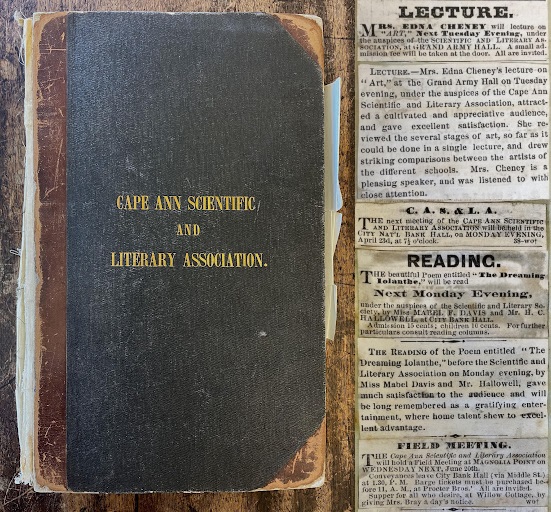
(Left) Cape Ann Scientific and Literary Association Records Book I, 1875-1922. (Right) Clippings from Cape Ann Scientific and Literary Association Scrapbook I, 1876-1887. Collection of the Cape Ann Museum Library & Archives, Gloucester, MA.
By former CAM Librarian & Archivist, Stephanie Buck
In late March of 1875, Dr. Herman E. Davidson invited a group of like-minded friends to his house on Middle Street to discuss forming a club dedicated to the “local and general advancement of Scientific and Literary knowledge.” By May a name had been agreed on - the Cape Ann Scientific and Literary Association - and so began the long history of collecting artifacts and presenting educational lectures and discussions of what is today the Cape Ann Museum.
Beginning in 1877 more educational opportunities were offered in the form of classes, starting with English Literature and language courses (French and German).
Today, the Cape Ann Museum continues to encourage this passion for the acquisition and dissemination of knowledge through education and entertainment, especially in the fields of art and the humanities. ■
One of Gloucester’s Earliest School Houses
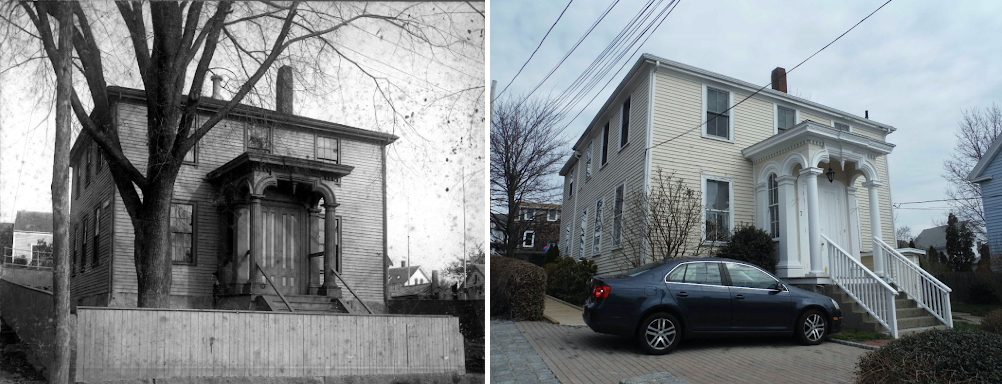
(Left) Beacon Street School, c. 1890s. Photograph presumed by R.W. Phelps. Collection of the Cape Ann Museum Library & Archives, Gloucester, MA. Gift of Joe Garland, 2006 [Acc. #2006.26]. (Right) From the City Assessor’s website; view of Beacon Street School in recent years.
From 1854 to 1898, this modest wooden framed building served as the Beacon Street primary school. It is located in central Gloucester at 7 Beacon Street and today is a private residence. The core of the structure was built in 1795 adjacent to Gloucester’s “poor farm” on what is now Emerson Avenue. In 1854 the building was lifted off its original foundation, moved to Beacon Street and updated appropriately. For the next 40-plus years it welcomed hundreds of excited students over its threshold.
It has been estimated that during the 1660s perhaps as much as half of the population of Gloucester could not read or write, a situation that would have been of great concern to town leaders. To counter this problem, the first public school in the community was established in 1698, 75 years after English settlers laid claim to the area. Within a decade, money had been appropriated for construction of a schoolhouse near the Town Green, a structure which is long gone. In the early 1740s, as the population slowly shifted away from the Green, a new schoolhouse was erected in the Harbor Village. In 1795, a second school was built in the village – the one shown here—to replace the earlier structure.
In the years following the Civil War, the population of Gloucester swelled. This was particularly true in the Harbor Village where families seeking work in the fisheries and related industries filtered into the community from throughout the region and from around the world. By the 1890s, the Beacon Street primary school could no longer meet the community’s needs and was deemed surplus. In 1897, the City granted the Gloucester Historical Society (a forerunner of the Cape Ann Museum) a ten-year lease for the building at just $1 per year. Before the lease ran out, the Association merged with the Cape Ann Scientific Association and vacated 7 Beacon Street. The building was subsequently used by the Spanish American veterans and as administrative space for the school department. The City held on to the property until 1964 when it was sold to the Calvary Chapel Baptist Church; in 2005 it became a private residence. ■
Moore’s Mathematics for the Masses
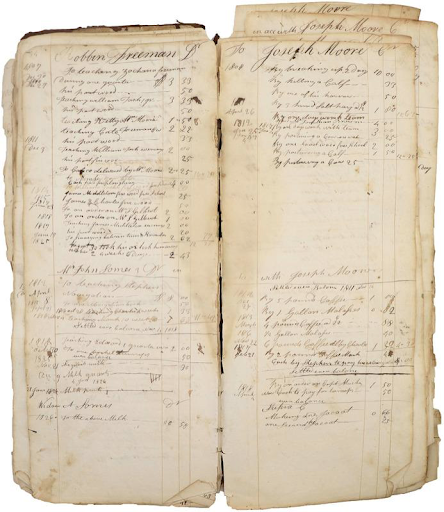
Account Book kept by Joseph Moore (1763-1845), 1805-1830. Collection of the Cape Ann Museum Library & Archives, Gloucester, MA.
Although Gloucester had a dedicated schoolhouse in the early Republic, much learning took place outside of formal classrooms. Joseph Moore (1763-1845), the son of a public school-teacher on Cape Ann, excelled at mathematics, and between 1790 and 1842 taught two generations of seafaring men at his home in Fresh Water Cove. Moore accepted cash and firewood as payment in exchange for his lessons; he also accepted services in lieu of payment, which are enumerated as credit in his account book, pictured above.
Moore’s account book also offers evidence that he taught girls, indentured servants, and African Americans. Entries on the upper left side of the account show the charges for teaching Robin Freeman’s sons, Cato (b. 1780) and Zacharia (b. 1789), who were African American. It is difficult to say how common the teaching of African Americans was at that time. Throughout the colonial period, there were no legal barriers to teaching enslaved people to read. However, writing instruction was banned in South Carolina and Georgia in the mid-eighteenth century. Practices were different in the North than the South but are hard to quantify, making Moore’s account book a valuable indication that education was not strictly limited to affluent white boys.
Twelve percent of the entries in Moore’s account book are charges for educating girls. Among the 177 entries in the book, the last names of 27 boys are different from those of their patrons, perhaps an indication that apprentices and servants were also receiving instruction. Indenture documents often stipulated that bound children be taught.
Explore the online archival exhibition “Unfolding Histories: Cape Ann before 1900” to learn more about early education on Cape Ann.
For further reading on the education of African Americans in the Northeast in the nineteenth century, pick up a copy of In Pursuit of Knowledge: Black Women and Educational Activism in Antebellum America by Professor Kabria Baumgartner. Kabria Baumgartner has been part of two presentations at the Cape Ann Museum which can both be found in the CAM Video Vault: Promises and Limits of the New Republic : A Closer Look at African Americans on Cape Ann in 2020 and African Americans in Essex County in 2021. ■
Educational Tools in the Collection
For anyone headed back to school this fall, chances are at least one notebook is high on the list of necessary supplies. But until the late 1800s, paper was expensive and difficult to obtain, and spiral notebooks did not appear until the early 20th century. During the 18th and 19th centuries, students relied primarily upon small slate tablets to do their individual practice work. Two of these from CAM’s collection are pictured below. The addition of a wood frame made the slate sturdier and provided a place to hold it without smudging the writing. Binding the edges of the frame with felt decreased the noise of placing the tablet on a desk. Originally, students used a slate or soapstone “pencil” to write on the surface; this eventually evolved into a piece of chalk or gypsum, which was softer and easier to erase.

(Left) Unattributed, Writing slate, n.d. Slate and wood. Gift of the Estate of Miss Dorothy Buhler, 1985. [Acc. #2466.8]. (Right) Unattributed, Slate, n.d. Slate and wood. Gift of E. Hyde Cox, 1968. [Acc. #1918.00]
Writing slates were also used in the maritime field as the one shown on the top right demonstrates. Sailors would record their compass readings in order to calculate distances and track their position.
Another back-to-school object in CAM’s collection is this Allen Educational Table that was patented by Edwin Allen of Windham, CT, in 1849. With moveable blocks of letters that slide into place along grooves in the wood, these were designed for practicing spelling in schools and at home long before the advent of spell-check! ■
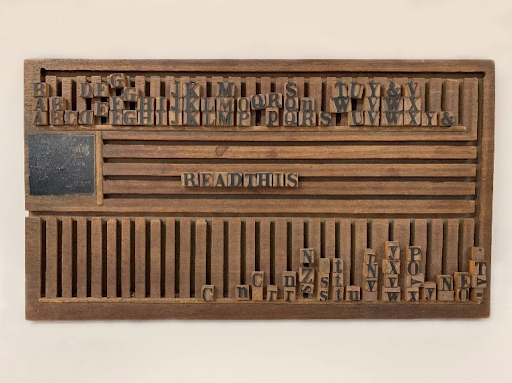
Edwin Allen, Spelling board, 1849. Wood. [Obj.337]
Girl’s Education in Early New England: School Girl Art
By CAM Docent, Trudi Olivetti
During the 1640s, Massachusetts enacted a law that all towns with 50 households or more would support a public school. As was the case with several jurisdictions fitting that criterion, Gloucester’s households were too far apart for one school, so there was likely some private instruction with paid tutors. By 1696 the selectmen voted to hire a school master, and one was found in 1698. The schools did not operate during the Revolutionary War, but were reopened afterward.
Educating girls was not considered as important as educating boys. Gloucester did not intentionally admit girls into the public school until 1707, when a new schoolhouse was built. There they learned reading, knitting and sewing.
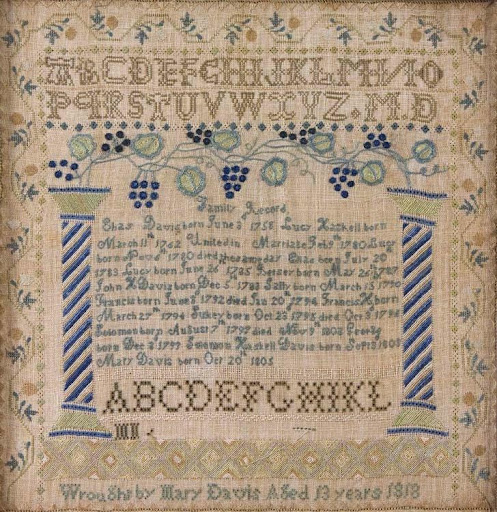
Mary Davis sampler, 1818. Wool on linen (in kitchen of Davis House). Collection of the Cape Ann Museum, Gloucester, MA
Traditionally, girls learned practical household skills from their mothers and other female relatives. The more well-to-do families could send their girls to so-called dame schools or female academies—several of them existed on Cape Ann. Some were boarding schools, where the students engaged in various types of artistic projects as well as reading, writing and arithmetic. The artistic instruction included pictorial needlework, weaving, rug hooking, painting, drawing and decorative “fancy” work. The artwork produced was a distinguishing element in American history from the late 17th century onward—it is actually felt to have had a significant impact on American culture. ■
Spoilt for Choice – Art Education on Cape Ann
As transportation improved during the mid-19th century and travel between Cape Ann and other areas became easier, established artists began visiting the area, setting up studios and opening their doors to eager students. Early on, choices and access were limited, especially for women. When William Morris Hunt opened his art classes to women in 1868, he attracted a large following among the wives and daughters of Boston’s wealthiest families. His classes were held in Magnolia, and among his students were Ellen Day Hale and Audella Beebe Hyatt (mother of Anna Hyatt Huntington). Soon after, in the 1890s, Frank Duveneck arrived in Gloucester with a coterie of artists who’d been trailing him through Europe since the late 1870s. Eventually artists looking for direction on Cape Ann were spoiled for choice.
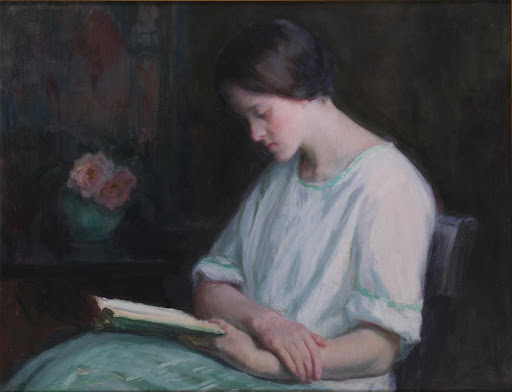
Ellen Day Hale (1855-1940), Portrait of Vera Cheves (1908-2007), c.1925, oil on canvas, gift of Vera L. Cheves, 1996 (Accession # 1996.57.1)
The 20th century saw an influx of art schools that catered to different styles, each with its own following. One group which included Allan Randall Freelon and Sidney Raynes formed around Hugh Breckenridge, who opened the “Breckenridge School of Painting” on Rocky Neck in 1920. Aldro Hibbard followed suit the following year in Rockport, opening the “Hibbard School of Painting.” A student at this school, Emile Gruppe, continued the pattern. Gruppe’s highly influential “Gloucester School of Painting” ran from 1940-1970 and helped spread a popular regional style of creamy, impressionistic brushwork sometimes referred to as the “Cape Ann School.” Modernists too found a haven to discuss painting theory at “The Thurn School of Modern Art.” This school, founded in East Gloucester by Ernest Thurn in 1927, contributed to the spread of modernism throughout Cape Ann and even featured Hans Hoffman as a guest instructor in 1933 and 1934.
As the 20th century progressed, many other circles of studies developed across Cape Ann. Art associations hosted lectures and discussions, and the artists who came to Cape Ann to study with well-known teachers such as Hunt, Breckenridge and Gruppe, soon organized classes of their own. ■
Library & Archives Reopening
Today is the day we’ve been looking forward to since March 2020. After 1 ½ years of being closed due to the pandemic, a completely remodeled and reorganized Library & Archives will reopen at the Cape Ann Museum at 27 Pleasant Street in Gloucester. And what better time to do so than the fall when we traditionally turn our focus toward our educational pursuits. The CAM Library & Archives is a welcoming and enjoyable space to visit and to do research, and the Library team looks forward to assisting your studies—whether they be house histories, genealogy, local history, research into a specific artist, the maritime or granite industries, or just browsing through our 20,000 digital historic images, we’re here to help.
For details about the Grand Reopening event tonight for CAM Members between 5-7pm, and to register, please click here.
And tomorrow, Friday, September 10 from 10am to 5pm, everyone is invited to join for the CAM Library & Archives Community Open House. Please click here to register.
The CAM Library & Archives regular hours, starting the week of September 14th, will be Tuesday through Thursday, 10am to 5pm. ■
For questions or more information, please contact Trenton Carls at trentoncarls@capeannmuseum.org or 978-283-0455 x119
Cape Ann Museum Book Club
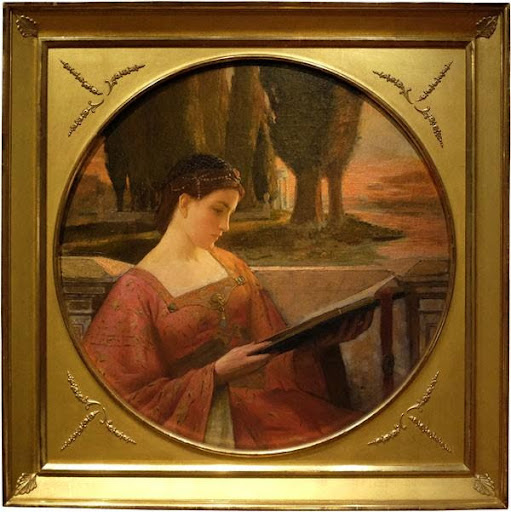
Charles Allan Winter (1869–1942), Woman Reading, c. 1898. Oil on canvas. Collection of the Cape Ann Museum, Gloucester, MA. Museum purchase, 2015. Funds provided by Arthur Ryan. [2015.52]
The Cape Ann Museum will host virtual book club meetings via Zoom beginning in October and running through May. A Museum docent and staff member will participate to facilitate discussion, to allow for a flow of ideas, and to provide connections to the collections and history of Cape Ann. The 2021-2022 CAM Book Club will start with Brethren by Nature by Margaret Ellen Newell which will be discussed on Thursday, October 21, from 10:30-12:00 pm. Margaret Ellen Newell will be giving a presentation on Saturday, October 16, at 2:00 pm that book club members and the general public are invited to attend. For more information on the event, click here.
All community members are encouraged to read along and keep an eye out for related programming and exhibits this year. The book club is free and open to all, but space is limited and reservations are required.
Click here for more information and to register. ■
Unsubscribe | Forward | View in browser
CAPE ANN MUSEUM
27 Pleasant Street, Gloucester, MA 01930
CAPE ANN MUSEUM GREEN
13 Poplar Street, Gloucester, MA 01930
Cape Ann is one of the most important places in the history of American art and industry.
The Cape Ann Museum, thanks to supporters like you, celebrates the history and remarkable contributions of this place to the cultural enhancement of our community and the world at large - yesterday, today and tomorro

